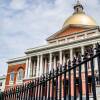On paper, America’s economy seems to be excelling. In March, the economy added 196,000 new jobs while the unemployment rate sat at 3.8 percent. Meanwhile, American startups like Uber and Pinterest are expected to go public with multi-million or higher valuations. But MIT economists Jonathan Gruber and Simon Johnson believe this hides a darker truth about the American economy: It’s slowly falling behind the rest of the world.
In their new book, “Jump-Starting America: How Breakthrough Science Can Revive Economic Growth and the American Dream,” Gruber and Johnson lay out their plan for how the United States can reclaim its mantle as a leader in not just gross domestic product, but also innovation and science. The key, they say, is government investment and encouragement in the scientific sector.
“We need growth [and] we need productivity, everyone across the political spectrum recognizes that. The question is: How do you get it? And the answer is not just the private sector or just the government, it’s the partnership,” Johnson said during an interview with Boston Public Radio on Tuesday. “We need government strategic investments to develop the basic science — recognize there’s a lot of spillover effects —and we need to make it easier for private businesses to build on that and spread it around the country.”
According to Johnson and Gruber, the dominant strain of thinking when it comes to research and development has been to leave it in the hands of the private sector, but they say this is a misguided approach. Gruber contends that while the private sector has been successful in building on innovation, its output has, and will, never be able to compete with the results from government-sponsored scientific research.
“What causes growth is productivity — how much we produce per hour we work — and what increases productivity is invention and innovation,” Gruber said. “Real innovation isn’t done by any one private company because a private company is interested in their bottom line.”
One example, they say, that highlights the power of a strong public and private sector partnership is Silicon Valley. Buoyed by the development of RADAR and ARPANET by the Department of Defense, the private sector was able to expand on these innovations to design the microchip, the personal computer, and eventually lead the world in advances in artificial intelligence and machine learning.
However, as investment in the sciences has steadily been clawed back, Gruber worries that the United States is losing its scientific edge to the rest of the world, which will ultimately be harmful to the economy.
“We’re falling behind, but we’re not too far behind yet,” Gruber said. “A great example is synthetic biology. ... We invented this industry, largely at MIT. We dominated the industry. Now, suddenly the [National Science Foundation] stopped funding it. China has now developed a whole set of research centers to this industry. They’re taking over. It’s not too late, but we’re losing that lead, and we need to get back in the lead.”
The economists are optimistic, however, that the United States can regain its lead and eventually develop a robust economy that sees economic growth and investment in the sciences. And not just in places like Boston or San Francisco, but throughout the rest of the country, where Johnson says there is a wealth of untapped talent and potential. They estimate there are at least 102 potential scientific hubs scattered across the U.S.
“The coastal superstar cities have become extremely expensive, but there’s a tremendous amount of talent spread across the U.S.,” Johnson said. “Good living conditions also matter. People also want to live in a place [with a] good climate, much better commute times than you have in the megacities, and low crime rates. Those are our very simple, transparent criteria.”




